This refers to a crossing of the eyes (“esotropia”) caused by farsightedness. Accommodative esotropia is a type of strabismus. Strabismus refers to any misalignment of the eyes.
Children who are farsighted easily and automatically focus on objects at distance and near through “accommodation”. Accommodation refers to the contraction of a small muscle inside the eye to cause the natural lens in the eye to change its shape and allow images to focus properly on the back surface of the eye. As a result, a child who is farsighted usually does not have blurred vision. However, in some children who are farsighted, this accommodative effort is associated with a reflex crossing of the eyes. Hence the term, “accommodative esotropia.”
Accommodative esotropia can begin anywhere from 4 months to 6 years of age. The usual age of onset is between 2 and 3 years of age.
WHAT ARE THE SIGNS OF ACCOMMODATIVE ESOTROPIA?
A noticeable crossing of the eyes is usually the primary sign. This crossing may only be evident when your child intently views a near object or when your child is tired or not feeling well. Some children will complain of double vision or may be seen squinting or rubbing one of the eyes.
DIAGNOSIS AND TREATMENT
The pediatric ophthalmologist will perform all of the necessary tests to confirm that your child has an accommodative esotropia. This includes an examination with dilating eye drops to determine the degree of farsightedness and to make sure the eyes are otherwise normal.
Full-time use of the appropriate farsighted glasses will often control the esotropia. When wearing the glasses, your child will not need to accommodate and hence the associated eye crossing reflex will disappear. However, after removing the glasses, the crossing will reappear, perhaps even more than before your child began wearing glasses.
Sometimes the glasses will only cause the crossing to disappear when your child looks in the distance. However, when gazing at near objects, crossing may persist despite the use of the glasses. In these circumstances, a bifocal lens is usually prescribed to permit your child to have straight eyes at all viewing distances .
What about Eye Patches?
It is not uncommon that children with accommodative esotropia will have decreased vision in one eye (usually the eye that does most or all of the crossing). This is known as amblyopia. If there is a significant amblyopia present, the pediatric ophthalmologist will prescribe the appropriate eye patch to be worn over the stronger eye or Atropine eye drops that will blur the stronger eye to force your child to use and strengthen the eye with amblyopia. The glasses must also be worn when using the patch or Atropine eye drops.
Can Surgery Correct the Problem?
If the farsighted glasses control the crossing of the eyes, eye muscle surgery is never recommended! In some children, the glasses will diminish the crossing partially or not at all. Some children whose esotropia was previously controlled with glasses may “deteriorate” and have a significant crossing even when wearing the glasses. If a significant crossing is evident despite the proper glasses, eye muscle surgery is then required to establish good ocular alignment.
Will My Child Outgrow This Problem?
The degree of farsightedness will often increase gradually until age eight years. After age eight years, the farsightedness typically diminishes each year. Many children will be able to maintain straight eyes without glasses in their early teen years. Some children will no longer need their glasses at an earlier age while others will need the proper farsighted glasses or contact lenses to control the esotropia even as adults. At the appropriate time, our physicians will attempt to wean your child’s dependency from glasses.
WHY IS GOOD OCULAR ALIGNMENT IMPORTANT IN CHILDHOOD?
Aside from the obvious improvement in your child’s appearance when misaligned eyes are corrected, there are other functional benefits to consider.
When a significant ocular misalignment exists in childhood, the brain’s developing visual system does not acquire binocular vision. Aside from improved depth perception, a person with binocular vision tends to maintain good ocular alignment throughout life. Additionally, a child with good ocular alignment is at decreased risk for developing amblyopia.


Four-year old girl with accommodative esotropia. Farsighted glasses control all of the eye crossing.
Pediatric Ophthalmic Consultants
40 West 72nd Street, New York, NY 10023 | 212-981-9800
The content of this Web site is for informational purposes only. If you suspect that you or your child has any ocular problem,
please consult your pediatrician, family practitioner, or ophthalmologist to decide if a referral to a pediatric ophthalmologist is required.




























